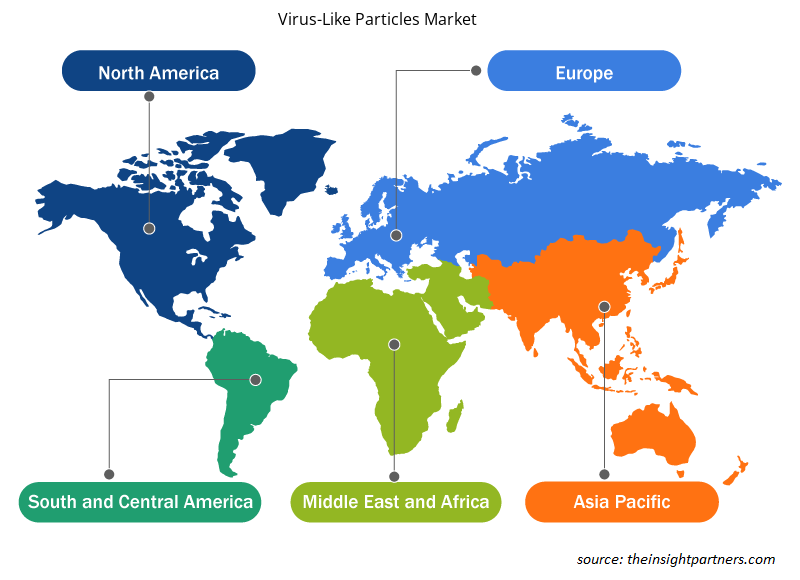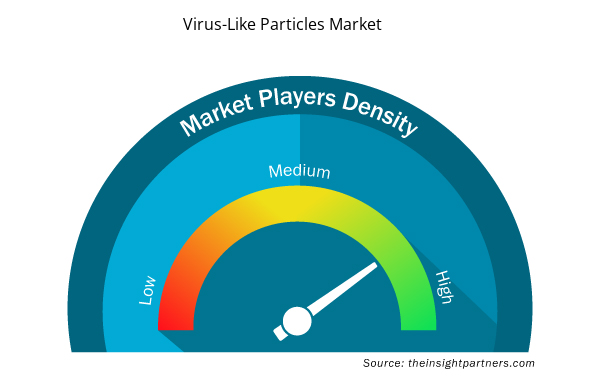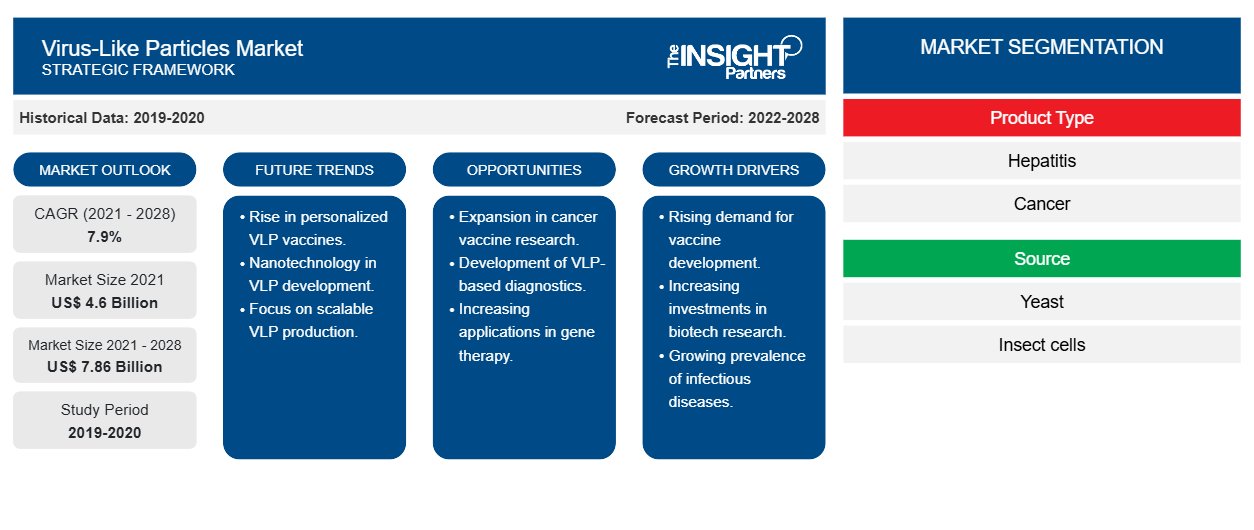病毒样颗粒 (VLP) 市场规模预计将从 2021 年的 46.0184 亿美元增至 2028 年的 78.5882 亿美元;预计 2021 年至 2028 年的复合年增长率为 7.9%。
病毒样颗粒疫苗在人类和动物病毒中的商业化、病毒样颗粒疫苗研发的积极开展以及病毒样颗粒成为过敏性疾病的可靠免疫治疗平台是推动整体市场增长的关键因素。然而,与 eVLP 的设计、纯化和存储相关的技术挑战阻碍了整体市场的增长。此外,病毒样颗粒疫苗制造的复杂性,加上工艺(例如病毒样颗粒疫苗的下游加工)的过高成本和时间要求,进一步限制了全球市场的增长。此外,用于局部和新兴病毒性疾病以及癌症的病毒样颗粒疗法仍在开发中,这为整体市场增长带来了丰厚的机会。
2021-2028 年,北美很可能继续在病毒样颗粒市场占据主导地位。美国在北美市场占有最大份额,预计在预测期内将继续保持这一趋势。这主要归因于人们普遍观察到的对病毒感染的易感性,例如由不同变体引起的病毒性流感。此外,减毒活疫苗生产所需的持续研发活动迫使生物制药公司选择病毒样颗粒,这进一步支持了市场增长。
定制此报告以满足您的需求
您可以免费定制任何报告,包括本报告的部分内容、国家级分析、Excel 数据包,以及为初创企业和大学提供优惠和折扣
- 获取此报告的关键市场趋势。这个免费样品将包括数据分析,从市场趋势到估计和预测。
市场洞察
商业化的病毒样颗粒疫苗推动整体市场增长
据 Frontiers Media SA 报道,第一种病毒样颗粒疫苗是为对抗致命病毒乙肝而设计的,与传统疫苗相比,病毒样颗粒疫苗的安全性令人鼓舞。第一种商业化的病毒样颗粒疫苗是针对乙肝病毒的。此外,商业化的抗乙肝疫苗,即葛兰素史克生产的“Engerix”和默克公司的“Recombivax HB”于 1980 年获批,它们都是病毒样颗粒。下一种商业化的病毒样颗粒疫苗是“Gardasil”,于 2006 年获批用于预防人乳头瘤病毒 (HPV) 感染。此外,病毒样颗粒还用于兽医学。第一种基于病毒样颗粒的商业化兽医疫苗被证明对猪圆环病毒 2 型 (PCV2) 有效。
病毒样颗粒在开发针对过敏性疾病的免疫治疗产品中的作用进一步刺激了整个市场的增长。病毒样颗粒用于治疗过敏性鼻炎、哮喘和尘螨反应。上述因素推动了整个病毒样颗粒市场呈指数级增长。病毒样颗粒疫苗表现出快速的免疫反应,副作用为轻微的皮肤反应。
基于产品类型的洞察
根据产品类型,病毒样颗粒市场细分为肝炎、癌症/HPV 和戈谢病。肝炎细分市场将在 2021-2028 年期间占据较大的市场份额。Frontiers SA 报告指出,丙型肝炎病毒 (HCV) 感染了全球 2% 的人口,是导致肝病和肝移植的主要原因。这种医疗威胁可以通过引入新的抗病毒疗法来部分解决。例如,针对高风险静脉注射吸毒者的有效率为 50-80% 的疫苗可显着降低人群中的 HCV 发病率。因此,病毒样颗粒代表了一种安全且高度免疫原性的疫苗递送平台,可诱导适应性免疫反应。目前有几种基于病毒样颗粒的疫苗正在临床试验中;然而,获得许可的 HBV 和 HPV VLP 疫苗早已投入使用。因此,基于病毒样颗粒的疫苗已证明其与有利的免疫学特性相关的有效性,使其成为有前途的 HCV 疫苗之一。
基于来源的洞察
根据来源,病毒样颗粒 (VLP) 市场分为酵母、昆虫细胞、植物和其他。酵母部分占有相当大的市场份额,预计在预测期内将继续保持类似的趋势。病毒样颗粒由异源表达系统产生,涉及酵母或杆状病毒以及植物和细菌。使用酵母表达系统生产的病毒样颗粒疫苗的安全性有助于酵母类病毒样颗粒市场的增长。
基于应用的洞察
根据应用,病毒样颗粒市场细分为疫苗和治疗剂。疫苗部分将在 2021 年占据相当大的市场份额,并且在预测期内也可能继续在市场中占据主导地位。疫苗接种被认为是控制人类和动物病原体和预防疾病的最有效方法之一。基于病毒样颗粒的疫苗因其固有的免疫原性和安全性而成为最有吸引力的方法之一。例如,病毒样颗粒是具有颗粒结构的非传染性多聚体抗原,适合诱导安全有效的体液和细胞免疫反应。除此之外,病毒样颗粒疫苗已证明其在兽医领域的有效性。病毒样颗粒仅由一种或多种结构蛋白组成,不存在天然病毒的基因组,也不能在细胞中自我复制。然而,可以根据血清学监测的要求生产含有单价或多价抗原的病毒样颗粒,病毒样颗粒疫苗在兽医领域的应用前景广阔。在区分感染动物和接种动物 (DIVA) 疫苗接种策略下利用病毒样颗粒疫苗对抗动物疾病就是其中一个例子。
在病毒样颗粒 (VLP) 市场运营的公司采用产品创新战略来满足全球不断变化的客户需求,这也使他们能够在全球市场上保持自己的品牌名称。
病毒样颗粒市场报告范围
病毒样颗粒市场区域洞察
Insight Partners 的分析师已详细解释了预测期内影响病毒样颗粒市场的区域趋势和因素。本节还讨论了北美、欧洲、亚太地区、中东和非洲以及南美和中美洲的病毒样颗粒市场细分和地理位置。

- 获取病毒样颗粒市场的区域特定数据
病毒样颗粒市场报告范围
| 报告属性 | 细节 |
|---|---|
| 2021 年市场规模 | 46亿美元 |
| 2028 年市场规模 | 78.6亿美元 |
| 全球复合年增长率(2021 - 2028) | 7.9% |
| 史料 | 2019-2020 |
| 预测期 | 2022-2028 |
| 涵盖的领域 | 按产品类型
|
| 覆盖地区和国家 | 北美
|
| 市场领导者和主要公司简介 |
|
市场参与者密度:了解其对商业动态的影响
病毒样颗粒市场正在快速增长,这得益于最终用户需求的不断增长,这些需求源于消费者偏好的不断变化、技术进步以及对产品优势的认识不断提高等因素。随着需求的增加,企业正在扩大其产品范围,进行创新以满足消费者的需求,并利用新兴趋势,从而进一步推动市场增长。
市场参与者密度是指在特定市场或行业内运营的企业或公司的分布情况。它表明在给定市场空间中,相对于其规模或总市场价值,有多少竞争对手(市场参与者)存在。
在病毒样颗粒市场运营的主要公司有:
- 默克公司
- 葛兰素史克公司
- 辉瑞公司
- Dynavax 技术
- 赛诺菲
免责声明:上面列出的公司没有按照任何特定顺序排列。

- 获取病毒样颗粒市场顶级关键参与者概览
病毒样颗粒 (VLP) 市场 – 按产品类型
- 肝炎
- 癌症/HPV
- 戈谢病
病毒样颗粒 (VLP) 市场 – 按来源划分
- 酵母
- 昆虫细胞
- 植物
- 其他的
病毒样颗粒 (VLP) 市场 – 按应用划分
- 疫苗
- 疗法
病毒样颗粒 (VLP) 市场 – 按地区划分
- 北美
- 我们
- 加拿大
- 墨西哥
- 欧洲
- 法国
- 德国
- 意大利
- 英国
- 西班牙
- 欧洲其他地区
- 亚太地区 (APAC)
- 中国
- 印度
- 韩国
- 日本
- 澳大利亚
- 亚太地区其他地区
- 中东和非洲 (MEA)
- 南非
- 沙特阿拉伯
- 阿联酋
- MEA 其他地区
- 南美洲和中美洲(SCAM)
- 巴西
- 阿根廷
- 其余的骗局
公司简介
- 默克公司
- 葛兰素史克公司
- 辉瑞公司
- Dynavax 技术
- 赛诺菲
- 万泰生物制药
- 印度血清研究所私人有限公司
- 印度生物技术公司
- LG化学
- VBI 疫苗公司
- 历史分析(2 年)、基准年、预测(7 年)及复合年增长率
- PEST 和 SWOT 分析
- 市场规模价值/数量 - 全球、区域、国家
- 行业和竞争格局
- Excel 数据集


- Online Exam Proctoring Market
- Nuclear Waste Management System Market
- Data Center Cooling Market
- Artificial Intelligence in Healthcare Diagnosis Market
- Grant Management Software Market
- Nurse Call Systems Market
- Battery Testing Equipment Market
- Surgical Gowns Market
- Retinal Imaging Devices Market
- Carbon Fiber Market

Report Coverage
Revenue forecast, Company Analysis, Industry landscape, Growth factors, and Trends

Segment Covered
This text is related
to segments covered.

Regional Scope
North America, Europe, Asia Pacific, Middle East & Africa, South & Central America

Country Scope
This text is related
to country scope.
常见问题
American Society for Microbiology defines virus-like particles (VLP's) as non-infectious multiprotein structure that are engineered to self-assemble from viral structure proteins. VLP technology proves to be a very powerful tool involved in development of vaccines. Several VLP based vaccines exist in the global market involving hepatitis B virus and human papillomavirus.
Commercial VLP based vaccines against human and animal viruses, intensive research and development activities for the development of VLPs based vaccines effective against viral infections, and VLPs acting as the best immunotherapy platform for allergic diseases are the key driving factors responsible for the overall market growth.
Based on product-type, hepatitis segment took the forefront lead in the worldwide market by accounting largest share in 2020 and is expected to continue to do so till the forecast period.
The vaccine segment dominated the global virus-like particles (VLP's) market and accounted for the largest revenue of 4,558.08 Mn in 2021.
Answer: - Merck & Co., Inc., GlaxoSmithKline plc., Pfizer Inc., Dynavax Technologies, Sanofi, Wantai BioPharm, Serum Institute of India Pvt. Ltd., BHARAT BIOTECH, LG Chem, and VBI Vaccines Inc. are among the leading companies operating in the global Virus-Like Particles (VLP's) market
Global virus-like particles (VLP's) market is segmented by region into North America, Europe, Asia Pacific, Middle East & Africa, and South & Central America. In North America, the U.S. is the largest market for virus-like particles (VLP’s). The US is estimated to hold the largest share in the virus-like particles (VLP’s) market during the forecast period. Presence of top players and favorable regulations related to product approvals coupled with commercializing new products are the contributing factors for the regional growth. Additionally, increasing number of R&D activities is the key factor responsible for the Asia-Pacific regional growth for VLP’s accounting fastest growth of the region during the coming years.
Trends and growth analysis reports related to Life Sciences : READ MORE..
The List of Companies - Virus-like Particles (VLP's) Market
- Merck & Co., Inc.
- GlaxoSmithKline plc.
- Pfizer Inc.
- Dynavax Technologies
- Sanofi
- Wantai BioPharm
- Serum Institute of India Pvt. Ltd.
- BHARAT BIOTECH
- LG Chem
- VBI Vaccines Inc.
The Insight Partners performs research in 4 major stages: Data Collection & Secondary Research, Primary Research, Data Analysis and Data Triangulation & Final Review.
- Data Collection and Secondary Research:
As a market research and consulting firm operating from a decade, we have published and advised several client across the globe. First step for any study will start with an assessment of currently available data and insights from existing reports. Further, historical and current market information is collected from Investor Presentations, Annual Reports, SEC Filings, etc., and other information related to company’s performance and market positioning are gathered from Paid Databases (Factiva, Hoovers, and Reuters) and various other publications available in public domain.
Several associations trade associates, technical forums, institutes, societies and organization are accessed to gain technical as well as market related insights through their publications such as research papers, blogs and press releases related to the studies are referred to get cues about the market. Further, white papers, journals, magazines, and other news articles published in last 3 years are scrutinized and analyzed to understand the current market trends.
- Primary Research:
The primarily interview analysis comprise of data obtained from industry participants interview and answers to survey questions gathered by in-house primary team.
For primary research, interviews are conducted with industry experts/CEOs/Marketing Managers/VPs/Subject Matter Experts from both demand and supply side to get a 360-degree view of the market. The primary team conducts several interviews based on the complexity of the markets to understand the various market trends and dynamics which makes research more credible and precise.
A typical research interview fulfils the following functions:
- Provides first-hand information on the market size, market trends, growth trends, competitive landscape, and outlook
- Validates and strengthens in-house secondary research findings
- Develops the analysis team’s expertise and market understanding
Primary research involves email interactions and telephone interviews for each market, category, segment, and sub-segment across geographies. The participants who typically take part in such a process include, but are not limited to:
- Industry participants: VPs, business development managers, market intelligence managers and national sales managers
- Outside experts: Valuation experts, research analysts and key opinion leaders specializing in the electronics and semiconductor industry.
Below is the breakup of our primary respondents by company, designation, and region:

Once we receive the confirmation from primary research sources or primary respondents, we finalize the base year market estimation and forecast the data as per the macroeconomic and microeconomic factors assessed during data collection.
- Data Analysis:
Once data is validated through both secondary as well as primary respondents, we finalize the market estimations by hypothesis formulation and factor analysis at regional and country level.
- Macro-Economic Factor Analysis:
We analyse macroeconomic indicators such the gross domestic product (GDP), increase in the demand for goods and services across industries, technological advancement, regional economic growth, governmental policies, the influence of COVID-19, PEST analysis, and other aspects. This analysis aids in setting benchmarks for various nations/regions and approximating market splits. Additionally, the general trend of the aforementioned components aid in determining the market's development possibilities.
- Country Level Data:
Various factors that are especially aligned to the country are taken into account to determine the market size for a certain area and country, including the presence of vendors, such as headquarters and offices, the country's GDP, demand patterns, and industry growth. To comprehend the market dynamics for the nation, a number of growth variables, inhibitors, application areas, and current market trends are researched. The aforementioned elements aid in determining the country's overall market's growth potential.
- Company Profile:
The “Table of Contents” is formulated by listing and analyzing more than 25 - 30 companies operating in the market ecosystem across geographies. However, we profile only 10 companies as a standard practice in our syndicate reports. These 10 companies comprise leading, emerging, and regional players. Nonetheless, our analysis is not restricted to the 10 listed companies, we also analyze other companies present in the market to develop a holistic view and understand the prevailing trends. The “Company Profiles” section in the report covers key facts, business description, products & services, financial information, SWOT analysis, and key developments. The financial information presented is extracted from the annual reports and official documents of the publicly listed companies. Upon collecting the information for the sections of respective companies, we verify them via various primary sources and then compile the data in respective company profiles. The company level information helps us in deriving the base number as well as in forecasting the market size.
- Developing Base Number:
Aggregation of sales statistics (2020-2022) and macro-economic factor, and other secondary and primary research insights are utilized to arrive at base number and related market shares for 2022. The data gaps are identified in this step and relevant market data is analyzed, collected from paid primary interviews or databases. On finalizing the base year market size, forecasts are developed on the basis of macro-economic, industry and market growth factors and company level analysis.
- Data Triangulation and Final Review:
The market findings and base year market size calculations are validated from supply as well as demand side. Demand side validations are based on macro-economic factor analysis and benchmarks for respective regions and countries. In case of supply side validations, revenues of major companies are estimated (in case not available) based on industry benchmark, approximate number of employees, product portfolio, and primary interviews revenues are gathered. Further revenue from target product/service segment is assessed to avoid overshooting of market statistics. In case of heavy deviations between supply and demand side values, all thes steps are repeated to achieve synchronization.
We follow an iterative model, wherein we share our research findings with Subject Matter Experts (SME’s) and Key Opinion Leaders (KOLs) until consensus view of the market is not formulated – this model negates any drastic deviation in the opinions of experts. Only validated and universally acceptable research findings are quoted in our reports.
We have important check points that we use to validate our research findings – which we call – data triangulation, where we validate the information, we generate from secondary sources with primary interviews and then we re-validate with our internal data bases and Subject matter experts. This comprehensive model enables us to deliver high quality, reliable data in shortest possible time.


 获取此报告的免费样本
获取此报告的免费样本